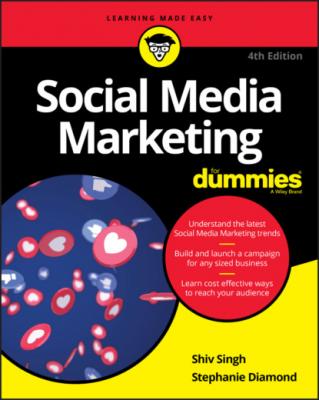Social Media Marketing For Dummies. Shiv Singh
Читать онлайн.| Название | Social Media Marketing For Dummies |
|---|---|
| Автор произведения | Shiv Singh |
| Жанр | Маркетинг, PR, реклама |
| Серия | |
| Издательство | Маркетинг, PR, реклама |
| Год выпуска | 0 |
| isbn | 9781119617020 |
Lifestyle
Games
Entertainment
Education
Family and kids
Music
If your company sells a product or service in one of those areas, you’ll likely choose to create a consumer app in that area. But what if you run a manufacturing company or do field sales? Does this mean that you can’t create an app? Not at all. In fact, you can create apps that provide a solution for your employees too. For example, if you are a manufacturing company, you could create an app that searches your catalog part numbers. Areas such as transaction processing, field sales, and competitive intelligence are all possible areas to create an app for. See Chapter 23 for more detailed information on mobile marketing and creating apps.
FIGURE 2-12: BlitzLocal.
Chapter 3
Getting in the Social Media Marketing Frame of Mind
IN THIS CHAPTER
The true power of social media marketing comes from applying its principles to all parts of your business in a rigorous fashion. This begins with examining social media marketing in relation to your marketing funnel. You then need to understand how it relates to brand marketing and direct response — the two traditional pillars of marketing that support the marketing funnel. Understanding the differences helps you to better know when to deploy social media marketing tactics versus when to depend upon brand or direct-response tactics.
In this chapter, we also discuss how big and little ideas relate to social media marketing. The marketing world has historically been driven by the big ideas. Whether it’s been the glamorous advertising (Apple’s iconic 1984 commercial comes to mind) or the clever in-store promotions that you see when you walk down the aisle at your local Whole Foods, ideas drive marketing. That changes with social media marketing. We explain how you need to think about the big idea a little differently as you deploy social media marketing to meet your marketing and business objectives.
Putting SMM in the Context of the Marketing Funnel
The marketing funnel is one of the most important metaphors in marketing today. It differentiates between prospects and customers, and maps out the journey from the point where a prospect learns about a product to when he becomes a loyal, repeat customer. Because practically every marketer uses some form of the marketing funnel, it serves an important framework through which to understand social media marketing.
The traditional marketing funnel typically has five stages, as defined by Forrester. These five stages are awareness, consideration, preference, action, and loyalty (as shown in Figure 3-1). The last stage (loyalty) has the fewest people. Those customers are the most loyal and, therefore, among the most valuable. For many marketers, marketing is fundamentally the act of moving people from having an awareness of a product, considering it along with other products, and establishing a preference for the product over the others, to eventually taking action such as purchasing it and developing loyalty toward it.
FIGURE 3-1: A marketing funnel.
You employ different marketing strategies and tactics at every stage of the marketing funnel to move the prospects along. The movement of prospects and customers is measured precisely (especially when you do this online), and if there isn’t enough movement, you need to devote more marketing dollars to pushing people through the funnel. How you spend these dollars and which investments do the most to move people through the marketing funnel is always a subject of much debate and varies by product category. Regardless, social media marketing and tapping into the social influencers with differing tactics can help with this journey.
SMM at the awareness stage
The awareness stage of the marketing funnel is where you introduce potential customers to your brand. You build awareness and encourage prospective customers to remember your brand name so that when they do make a purchase in the future, they include your brand in their consideration mix.
Typically, marketers use television, radio, print, and direct mail to build awareness. They also sponsor events, conduct promotions, and invest in product placements to get further exposure. Marketers also use public relations professionals to influence editorial content in magazines and newspapers.
In the digital realm, you typically create awareness using display advertising on major websites, paid searches for category-related keywords, video advertising on YouTube and Facebook, and sponsorships across the web. Email marketing has also been successful at building awareness. Historically, creating awareness online is a lot cheaper but without the same mass scale effect of a 30-second television spot.
You can use social media marketing to build awareness of your brand, too. The reason is simple: As a marketer with a loyal customer base, you can encourage your customers to build your brand by talking about your product with their friends. Many a marketer has incentivized existing customers to tell their friends and families about their purchasing decisions. You aren’t the first. In fact, you can also reach out to expert influencers to help you here. One important consideration with using social media marketing at the awareness stage is whether your SMM efforts can give you the type of scale that you can get with television, radio, or print. For a long time, marketers believed that social media marketing couldn’t give that scale. That’s changing fast, thanks to the likes of
